The Magic Circle, 1886 John William Waterhouse (1849-1917)
Location: Tate Gallery London UKOriginal Size: 183 x 127 cm
Own a museum-quality reproduction of The Magic Circle by Waterhouse (1886), exclusively hand-painted in oils on linen canvas by European artists with academic training. Each masterpiece is created with meticulous craftsmanship, capturing the exceptional quality and authentic brushwork of the original painting.
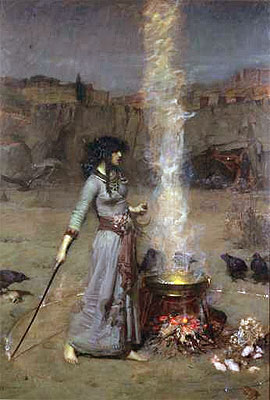
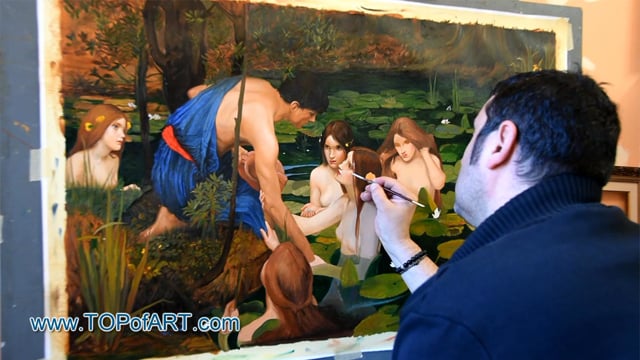
Recreating Waterhouse: A Video Journey into Museum-Quality Reproductions by TOPofART
Video showcasing the process of hand-painting a Waterhouse masterpiece with the utmost precision and care for detail.
Oil Painting Reproduction
If you want a different size than the offered
Description
Painted by European Аrtists with Academic Education
Museum Quality
+ 4 cm (1.6") Margins for Stretching
Creation Time: 8-9 Weeks
Creation Process
We create our paintings with museum quality and covering the highest academic standards. Once we get your order, it will be entirely hand-painted with oil on canvas. All the materials we use are the highest level, being totally artist graded painting materials and linen canvas.
We will add 1.6" (4 cm) additional blank canvas all over the painting for stretching.
High quality and detailing in every inch are time consuming. The reproduction of John William Waterhouse also needs time to dry in order to be completely ready for shipping, as this is crucial to not be damaged during transportation.
Based on the size, level of detail and complexity we need 8-9 weeks to complete the process.
In case the delivery date needs to be extended in time, or we are overloaded with requests, there will be an email sent to you sharing the new timelines of production and delivery.
TOPofART wants to remind you to keep patient, in order to get you the highest quality, being our mission to fulfill your expectations.
We not stretch and frame our oil paintings due to several reasons:
Painting reproduction is a high quality expensive product, which we cannot risk to damage by sending it being stretched.
Also, there are postal restrictions, regarding the size of the shipment.
Additionally, due to the dimensions of the stretched canvas, the shipment price may exceed the price of the product itself.
You can stretch and frame your painting in your local frame-shop.
Delivery
Once the painting The Magic Circle is ready and dry, it will be shipped to your delivery address. The canvas will be rolled-up in a secure postal tube.
We offer free shipping as well as paid express transportation services.
After adding your artwork to the shopping cart, you will be able to check the delivery price using the Estimate Shipping and Tax tool.
Museum Quality
The paintings we create are only of museum quality. Our academy graduated artists will never allow a compromise in the quality and detail of the ordered painting. TOPofART do not work, and will never allow ourselves to work with low quality studios from the Far East. We are based in Europe, and quality is our highest priority.
Additional Information
Waterhouse modulates his palette with deliberate restraint. Dusty umbers and siennas dominate the barren ground and distant masonry, allowing the cool clarity of the robe and the sudden vermilion of the fire to command the gaze. The concentrated turquoise not only isolates the figure but also imbues her with an other-worldly authority; the eye registers the dress first, then climbs the luminous column of vapour to the silent, moonlit sky. The chromatic contrast works less as spectacle than as quiet insistence, persuading the viewer to accept the uncanny as natural.
Close inspection reveals a disciplined, economical facture. The artist lays thin, translucent glazes across the background, creating atmospheric depth without superfluous detail, while reserving denser, more tactile strokes for the foreground fire and folds of cloth. The smoke, feathered with fine, wet-into-wet touches, merges painterly bravura with narrative necessity. Compositionally, the vertical plume anchors the scene, counterbalanced by the sweeping diagonal of the wand and the faint, shimmering circumference of the magic circle—an elegant geometry that guides the eye in a measured circuit from ground to sky and back again.
Painted in 1886, the work discloses the period’s preoccupation with arcane knowledge and the femme fatale. Waterhouse, steeped in Pre-Raphaelite legacies yet alert to contemporary Orientalist fantasies, assembles an eclectic syntax of costume and symbol—the Saxon curls, the Persian embroidery, the Hecatean sickle. His witch is neither wholly malign nor purely decorative; she is the agent of a mysterious, self-contained rite whose meaning the painter refuses to resolve. That deliberate ambiguity, couched in fastidious craft, gives the picture its enduring, unsettling allure.
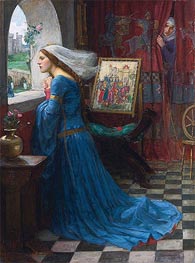
Fair Rosamund 1916
$1448
$69.76
John William Waterhouse
Original Size:96.5 x 72.5 cm
Private Collection
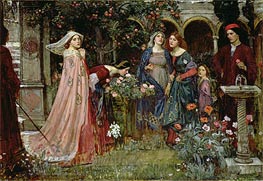
The Enchanted Garden c.1916/17
$2567
$64.98
John William Waterhouse
Original Size:115.5 x 160 cm
Lady Lever Art Gallery, Port Sunlight, UK
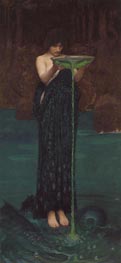
Circe Invidiosa 1892
$1390
$73.51
John William Waterhouse
Original Size:180.7 x 87.4 cm
Art Gallery of South Australia, Adelaide, Australia
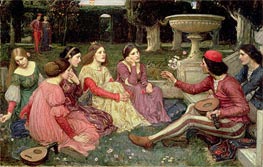
A Tale from the Decameron 1916
$3582
$62.05
John William Waterhouse
Original Size:101 x 159 cm
Lady Lever Art Gallery, Port Sunlight, UK
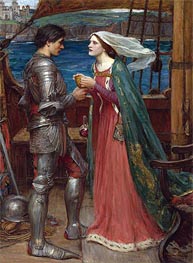
Tristan and Isolde with the Potion 1916
$1580
$69.08
John William Waterhouse
Original Size:108 x 72 cm
Private Collection